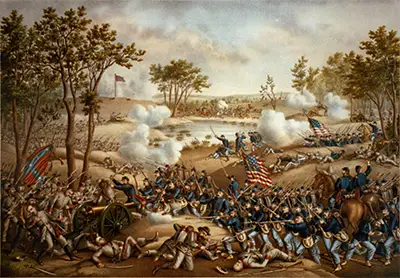Ulysses S. Grant: U.S. President, Civil War Victor
Grant's counterpart, Army of Northern Virginia Gen. Robert E. Lee, anticipated the strategy and ordered his own troop engagement to the very same place. Spotsylvania Court House was only 10 miles to the southeast of the Wilderness. The race was on. Union troops under Maj. Gen. Gouverner Warren set out at a marginally quick pace. Going even more quickly were Confederate infantry under Maj. Gen. Richard Anderson and Confederate cavalry under Maj. Gen. J.E.B. Stuart. Using local knowledge and avoiding the delays that continually plagued the movements of the sometimes cumbersome Army of the Potomac, the Confederate troops got there first. When the Union troops arrived, on May 9, they found Confederate troops dug in behind several miles of trenches. In addition, the defenders killed Maj. Gen. John Sedgwick while he was scouting the perimeter. The Battle of Spotsylvania Court House was a weeklong struggle, resulting in nothing so much as thousands of casualties on both sides. On May 20, Grant gave the order that Lee had been expecting all along, to move east and then head south. On May 31, Grant ordered the cavalry of Maj. Gen. Philip Sheridan to take control of Old Cold Harbor, a key crossroads on the road to Richmond, 10 miles northeast of the capital. When they arrived, they found it occupied by a force of Confederate cavalry and infantry. Sheridan's cavalry succeeded in driving the Confederates out of the crossroads, in the vicinity of the 1862 Battle of Gaines' Mill, part of the Battle of the 7 Days. The following day, a small Confederate attempt to retake the crossroads failed to dislodge the Union troops there. A Union attack later in the day enjoyed more success, but a Confederate counterattack negated that advantage and positions were very much the same as they were at the beginning of the day. Reinforcements poured in on both sides. 
Grant, with 108,000 troops at his disposal, ordered a large-scale attack for dawn on the following day. Various communication breakdowns and misadventures bedeviled the Union command structure, and no attack was forthcoming that day. Taking advantage of the lull in the fighting, Confederate troops numbering 62,000 dug in deeper and shored up their defenses tightly and smartly. On June 3, the next Union attack came. Nearly 50,000 strong, it rammed itself at the well entrenched Confederate defenders. In less than an hour, 7,000 Union men lay dead. The range and method of the defensive weaponry was so devastating that Union troops could not even retreat effectively; rather, they dug trenches and climbed in. Deciding that further attacks would be just as futile, Grant gave the order to move out. With this battle as well, the number of Union casualties was quite high, much moreso than for the Confederacy. Grant was still determined to get to Richmond. The next destination for the Army of the Potomac was the rail junction city of Petersburg. Next page > The Beginning of the End > Page 1, 2, 3, 4, 5, 6, 7 |
|
Social Studies for Kids
copyright 2002–2024
David White





